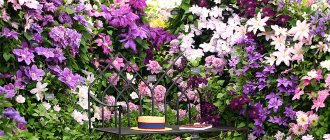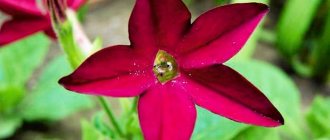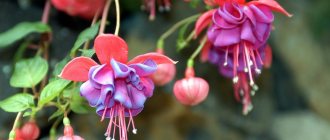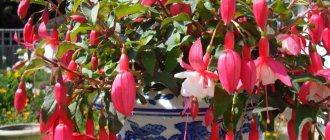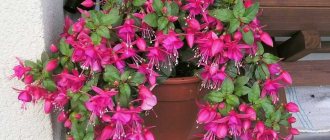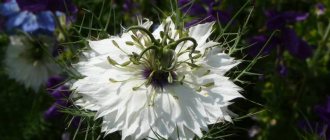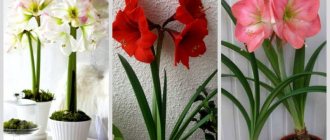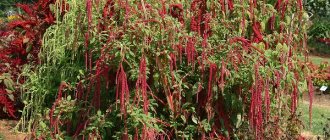The delicate flowering plant fuchsia belongs to the fireweed family and grows wild in South and Central America. The “national biography” of Fúchsia is interesting: it was first discovered and described by the French scientist Charles Plumier, the flower received its name in honor of the German physician and botanist Leonart Fuchs, and it received wide distribution and selection as an indoor species thanks to the British. The original shape of the flowers contributed to the emergence of other names: “gypsy earrings”, “ballerina”, “Japanese lantern”, “Chinese lantern”.
Fuchsia indoor flower - plant varieties
Sometimes, when hearing the word “fuchsia”, a person imagines a bright shade of pink. However, this is not entirely justified. Fuchsia is primarily a plant; depending on the species, it has flowers from white to purple shades. Fuchsia is an indoor flower. Multi-colored unusual buds are not interesting for bees. For this reason, the plant is pollinated by small hummingbirds. The pollen sticks to their beaks thanks to a special sticky substance secreted by the flower. Other interesting features of the plant are below in the article.
Addition to the TOP 10 best fuchsia varieties
The following varieties are not included in the top ten, since flower growers have not yet fully appreciated them, but they will amaze anyone with their flowering:
- Fuchsia variety Promessa, or fuchsia Ratatouille. No less interesting is the combination of white or soft pink with a rich purple tint. This is what open flowers look like. This plant does not have the largest corollas among the fuchsia varieties. The fuchsia variety Swingtime has a similar color, but the flowers have a peach rather than purple hue.
- Fuchsia Unusual. An ampelous plant that amazes those around with its delicate flowers covered with light fluff. The petals are delicate, pink and beige shades predominate. Sometimes this fuchsia variety has white flowers.
- Annabel fuchsia. A distinctive characteristic is that the main stem and appendages quickly become woody, creating a strong support for the petals. Thanks to this, the corollas became large and heavy, and the pedicels became thick and squat.
- Fuchsia Blue Angel. Despite the large flowers, this plant can be grown in hanging baskets. The vegetative reproductive organs are small in size, which allows the entire bush to fit in a small pot.
- Fuchsia Fey. The flowers of this ampelous fuchsia look the same as those of the Unusual variety. However, it has long stems, leaves and shoots.
- Fuchsia New Millennium. Elegant flowers of a dark purple shade, close to black, will stand out significantly among other varieties. Therefore, it is recommended to plant them separately so as not to overshadow the beauty of other elf flowers. Fuchsia Rohees New Millennium has a similar exotic appearance, however, some flowers may have signs of an intermediate nature of inheritance, that is, be lighter shades.
Description of the plant
Fuchsia belongs to the genus Onagricaceae, which has 100 species. Among them are shrubs, trees and hanging varieties. South America is home to the first representatives of this species. The flower was first discovered in 1696. The name was received in honor of the botanist Fuchs, who studied this species.
What does a fuchsia flower look like?
Fuchsia blooms very beautifully. The flower is a drooping bell with an upper border that is significantly different from the main shade. Inside the bell there are eight very long stamens. Above it is a four-lobed sepal.
Indoor fuchsia is called gracilis. Mexico is considered its homeland. Under natural conditions, this plant is presented in the form of a shrub. At home, it grows no more than 70 cm. It has dark green or green leaves. Flowers with long pedicels and axils. The heads are down.
There are inflorescences collected in a brush; they are characterized by bright colors, as well as with double colors. Depending on the genus, flowers are simple, double or semi-double. Flowering is characterized by a long duration. Hybrid varieties are common at home. Flowering begins in spring and ends in autumn.
Types of fuchsia with names and descriptions
Since fuchsia has been grown for more than 200 years (since the end of the 18th century), a large number of varieties and hybrids have now been bred. The diversity of natural species also contributed to successful selection. Let's look at the most famous representatives.
Bolivian
A meter-long branched shrub with luxurious dark green leaves up to 15 cm in length, dense, with teeth along the edge.
Bolivian
The flowers are large, tubular, the outer sepals are up to 6 cm, white-green or cream, pink on the lapels. The corolla is bright red, the stamens are moderately long and pink. They are attached with generous tassels to a long peduncle - up to 30 cm. They bloom profusely in spring and love warm rooms.
Three-leaved
The height of the bush reaches 60 cm, it is quite wide, suitable for large rooms and balconies. The leaves are ovate, up to 8 cm long, a red tint is present on both sides of the leaf blade: on top it is mixed with greenery, on the bottom – with brown. The leaves are collected together in groups of 3, hence the name. There is a little fluffiness on the veins.
Three-leaved
Blooms in whole bunches. The flower shape is long, bright red bells that contrast favorably with the leaves. Closed buds look like exotic fruits. Flowering is abundant and long, the period is May-October.
Some varieties have been bred on its basis: Coral, Mantilla, Thalia, Elfred Ott. They differ from the mother species in shades of the color palette: coral, pink, orange.
Magellan
It is a very large bush, can grow up to 3 meters in height. The leaves are small, about 4 cm, with fluff on the front side, figuredly jagged. The color is closer to purple on the underside and green on the outside. The stems are also reddish and fleecy.
Magellan
Magellan fuchsia flowers are two-colored, with very long stamens - the classic version of the “ballerina”. There are one on the stem, up to a maximum of 4 pieces. The buds are very similar to Chinese lanterns. It is good to use this variety for decorating arches, entrances, shop windows, and walls. An interesting fact about its winter hardiness: if the plant is trimmed, leaving 15 cm, and mulched with fallen leaves and hay, then it can be left to winter outside.
Recumbent
Very different from the usual form of Recumbent Fuchsia. She is the ancestor of hanging varieties. It has creeping thin ground cover stems, small light green almost round leaves with a fuzzy brown border.
Fuchsia recumbent
The flower is also quite unusual. Firstly, it does not droop, but rather stretches upward. The shape resembles a vase or goblet of a yellow-orange hue, inside of which there is a “bouquet” of red-blue exotic stamens. It blooms not profusely, but all summer and autumn. Used in flower arrangements where you need to cover a large area of soil or create a background for tall plants and structures.
Ampelnaya
This fuchsia is often used as a decorative element in the garden; hanging varieties can be found on the porch of houses in hanging pots. Many people don’t even imagine another option for themselves. At the same time, it is quite shade-tolerant and feels great in gazebos and terraces. The main thing is that there are no drafts, which will greatly interfere with flowering.
Ampelnaya
Particularly striking is the two-tone fuchsia, whose exotic bells hang from the flowerpots.
Thin
A shrub that can reach 3 m in height, with pubescent red stems and oval-lanceolate green medium-sized leaves on long cuttings.
Fuchsia Thin
Blooms profusely with large drooping purple-violet ballerina flowers with contrasting light stamens. Flowers are located on thin elongated peduncles. The species is valuable for its special decorative effect.
Thyroid
Another tall species. At home, if trimmed in time, it can grow up to 1 m. It has large, rough leaves up to 15-17 cm in length and 5-7 cm in width, the stems are erect and strong.
Fuchsia corymbosa
The flowers are collected in racemes, the size of the sepals is several times larger than the corolla, the color is soft red, turning into purple at the ends of the petals, creating a star effect. The stamens are inconspicuous and short. Blooms profusely from July to September.
Graceful
The large bush can compete with Magellan fuchsia, as it is its relative. There are specimens 3 m tall, although indoor plants will not exceed a meter. Leaves – 2.5-5 cm, elongated, jagged along the edge, smooth and green. The veins and stems are reddish.
Graceful
Large flowers are collected in inflorescences. The calyx and stamens are red, the corolla is purple. Their pedicels are interesting - they are so thin, and also purple, that they are almost invisible from a distance, so it gives the impression of flowers or red rain floating near the bush.
Shiny or shining
An evergreen densely branched shrub up to 2 meters, it is the mother plant for many racemose hybrids. The leaves are oval-heart-shaped, large: 15-20 cm long and 8-12 cm wide. Lint-free surface, rich green color.
Fuchsia brilliant
Flowers in hanging racemes, total length 10 cm, with small stamens. The sepal tube is thin. Color varies from crimson to red-purple. Flowering period – June-August.
Hybrid
The most common specimen of fuchsias found in apartments. After all, it is through crossing that the most daring and fantastic combinations are obtained.
Typically, hybrids have light, small and densely growing leaves with bright burgundy veins, and thin hanging stems. Often these are ampelous forms.
Fuchsia hybrid
The flowers are double, two-colored, bright and noticeable, they are larger in size than the leaves. Thanks to its drooping form, the plant has a spectacular appearance: the greenery is at the top and the inflorescences are at the bottom. And as usual, caring for hybrids is not particularly troublesome.
It will also be interesting: Cineraria - planting and care, plant types, annual or perennial? ?
Superstition about a flower
Fuchsia is a common flower. Once in the house, it becomes its decoration. She is credited with magical properties. The plant is not too picky, but requires special care. Loves moist soil. Watering should be organized so that the soil is always slightly moist. The main thing is not to over-moisten. In this case, negative consequences are possible, including the death of the plant.
Overdrying the soil also has negative consequences. In this case, the leaves fall off and the formation of flower stalks stops. There are some tips for proper plant care:
- if the leaves begin to become covered with brownish-yellow spots, then watering should be interrupted and wait until the soil dries;
- if the plant has withered and the soil is wet, then it needs to be moved to a sunnier place;
- the flower really likes washing and spray treatment.
It is useful to have this kind of plant for creative people. It gives them inspiration and fills them with energy. It grows and emits special energy.
In a house where representatives of several generations live, mutual understanding and prosperity will reign. The love that a person gives to this flower multiplies and returns to him in the form of an increase in inner beauty and charm.
For your information! In addition to all the positive qualities, fuchsia is considered a flower whose owner in most cases is a single woman. Many gardeners call fuchsia a widow's flower.
Insect pests and measures to combat them
Hydrangea paniculata: the best varieties for the Moscow region
All fuchsia varieties can be damaged by the following parasites:
- Greenhouse aphids. A small pale green insect sucks juice from young leaves. To destroy the pest, all surfaces in the greenhouse are washed with hot water with liquid potassium soap and actellik dissolved in it.
- Whitefly. The insect has a pair of wings and is capable of jumping and flying. Whitefly larvae suck sap from young stems and leaves. They destroy the pest with drugs that can be purchased in specialized stores.
- Spider mite. A tiny reddish insect covers the shoots and leaves with a mesh of the finest cobwebs, where it breeds its offspring. To eliminate the disaster, the plant is washed with hot soapy water or treated with special preparations.
Popular varieties
There are a large number of species and subspecies of this representative that can be grown in the Russian climate.
Fuchsia Annabelle
Refers to ampelous species. Characterized by abundant, long-lasting flowering. It has an average height of up to 40 cm. The flowers are large and double white. It is considered a white princess who can decorate any home or garden.
Fuchsia Voodoo
It has a very beautiful color, contrasting and bright. The skirt is dark purple, the sepals are intense red. Heart-shaped buds. It grows very quickly from the shoot and becomes a powerful plant. It blooms quite profusely. Voodoo is unpretentious and upright.
Fuchsia Ballerina
The variety is a classic representative of this genus. It is a self-branching bush. It has large, densely double peduncles that resemble a ballerina's tutu. Bred in England in 1894. Associated with childhood memories.
Fuchsia Marinka
Characterized by bright red sepals. The variety has simple dense flowers. The variety is distributed throughout the country. It is an ampelous variety. Blooms profusely. The bush is bright and lush.
Fuchsia Swingtime
Characterized by flowers with deep red sepals. The flower itself is white, the peduncles are double and thick. The variety has a long flowering period. It belongs to the bush representatives, but is described in the literature as a semi-ampelous subspecies. You can form an ampel.
Fuchsia Millennium
A very bright representative of the Fuchsia genus. It has a black cherry skirt and bright red sepals. The flowers are particularly large and terry. The bush reaches a height of up to 40 cm. Reproduction occurs by cuttings. The cuttings take root very well. The flowering plant looks exotic and attractive.
Fuchsia Dark Eyes
A very contrasting variety. The skirt is purple, decorated with bright pink sepals. Belongs to semi-hanging varieties. Has an average flowering time. The flowers are large and double. Recommended for growing in hanging pots. Reaches a height of up to 23 cm.
Fuchsia Natasha Sinton
Delicate attractive flower. It has a rich pink hue, which gives it a special charm. The flowers are large and double, looking like little angels. Characterized by a long flowering period. Refers to ampelous varieties.
Fuchsia Deep Purple
A very contrasting, charming variety. The skirt is purple, decorated with white sepals. Belongs to semi-hanging varieties. Has an average flowering time. The flowers are large and double. Recommended for growing in hanging pots.
Fuchsia Peachy
Refers to semi-ampel varieties. A very extravagant flower with a terry skirt of a cool pink shade, decorated with white sepals. The flowers are characterized by their particularly large size.
For your information! It has a long flowering period, during which the shade of the peduncle changes from pink to peach-salmon.
Fuchsia Lenny Erwin
Belongs to the ampelous variety. It has a light purple skirt and white sepals. The flowers are large in size and double, reminiscent of a rose flower. Reaches a height of up to 40 cm, has a bushy growth form. Reproduction occurs by cuttings. The cuttings take root very well.
Fuchsia Pink Marshmallow
The flowers are delicate and attractive. They look like little cupids. Characterized by increased terry and soft pink color. The variety will decorate any home. Has an average flowering time. Suitable for growing in hanging pots. Reaches a height of 25 cm.
Fuchsia El Camino
It belongs to the semi-ampelic varieties and is self-branching. Reaches a height of up to 30 cm. Flowering is early and long-lasting. The skirt has a white color and rich veining. Sepals are red. The flowers are large in size and double.
Fuchsia Gillian Althea
Belongs to the bush type of plants. The variety is contrasting and fits harmoniously into any interior. Attracts attention with its unusual colors. Blooms profusely and for a long time. Reaches a height of up to 50 cm. It is considered tall.
Fuchsia Royal Mosaic
Looks very specific. Has large purple flowers. The plant of this variety has fast growth and late flowering. Peduncles are very large. Has an average flowering time. Suitable for growing in hanging pots. Reaches a height of 25 cm.
Fuchsia Rocket Fire
Belongs to the bush type. It has a peculiar coloring of peduncles, which is characterized by a combination of purple and blue colors. Sepals are deep pink. The buds have a large elongated shape. The leaves are light green. He is one of the giants of his species.
Fuchsia Blacky
Belongs to the giant variety. Flowering is characterized by a large number of peduncles, which is twice as many as in conventional varieties. The sepals have a dark red tint, the bell itself is purple-black. Recommended for growing in hanging baskets. Reaches a height of up to 30 cm. This fuchsia is a hybrid.
Fuchsia Unusual
Belongs to the bush type. It has round peduncles of a soft pink hue. Characterized by abundant, long-lasting flowering. It has an average height of up to 40 cm. The flowers are large and double.
Fuchsia Water Nymph
It has red petals and pale pink sepals. This contrast gives a special piquancy and attractiveness. It blooms abundantly throughout the summer. Belongs to the bushy, vigorous type.
Fuchsia White King
It is one of the largest-flowered varieties with white flowers. Has double peduncles. Refers to the bush form. Flowers of this variety look attractive in any interior. It has large leaves that look especially extravagant on a large bush. Tolerates elevated air temperatures well.
What does fuchsia look like?
Varietal characteristics determine which flowering part of the plant will be - double or simple. Both double fuchsia and simple fuchsia have one peculiarity - their original flowers look like tiny dancers in fluffy skirts of various shades. Therefore, flower growers call the plant Japanese or Chinese lantern and elf flower. And in common parlance you can find the name gypsy earrings. Fuchsia also bears this name due to the presence of bright curved petals on each flower.
Important! An ornamental shrub can delight people with its flowering for a very long time. In some varieties, after the flowers fall, juicy berries-fruits are formed.
FUCHSIA. We save until spring. Secrets of proper maintenance in winter
Fuchsia has long been known to floriculture lovers. Our grandmothers also enjoyed decorating their window sills with it, and in the summer their gardens, terraces, and gazebos. Now many beautiful varieties have been bred and interest in this flower is constantly growing. Although this plant is suitable even for novice gardeners, for successful growth and long flowering, proper care and maintenance must be provided.
1. When placing, keep in mind that the plant does not like bright sunlight. East or north windows would be ideal. High air temperatures are also poorly tolerated. Therefore, in the warm season, it is better to take your pet out into the garden or onto an open balcony. It can be placed in the shade, in hanging flowerpots or planted in open ground.
2. Any loose mixture for flowering plants is suitable as a substrate. You can add a little chopped sphagnum moss and leaf humus (a teaspoon per pot). Before use, I recommend calcining garden soil in the oven and pouring potassium permanganate on it.
3. I recommend planting the flower in a ceramic container with thick walls in order to avoid overheating of the root system.
4. For irrigation, use well-settled, warm water, rain if possible. In summer, try not to let the earthen ball dry out. Spraying the leaves is also necessary. The quality and duration of flowering depends on this. With a lack of moisture, fuchsia may drop its buds and not open. In winter, on the contrary, watering is reduced, brought to 2 - 3 times a month.
5. Regular feeding, mineral and organic, is required. It is very good to alternate root and foliar feeding. In the warm months, as soon as the buds appear, fertilize every week, and from October, reduce and stop completely in winter.
6. Fuchsia is susceptible to attacks by whiteflies and spider mites. If found, immediately wash the leaves and spill them with soapy water. Next, treat with a special preparation. Repeat this procedure after a week. In the future, for prevention, use a solution of nettle and garlic.
For successful growth and even for preserving the specimen in winter, proper maintenance is important. Try to ensure the air temperature is up to 15 degrees. A decrease to +5 degrees is not dangerous for the flower. I noticed that with colder wintering, the plant becomes stronger and blooms more abundantly and more readily.
During this period, the plant needs pruning. For my pets, I carry out this procedure boldly, leaving 10–15 cm of the stem. Periodically cut off the awakened thin shoots. Sometimes buds may appear; be sure to remove them, otherwise there will be no lush flowering in the spring.
It's better not to worry about watering. This is done as rarely and as little as possible. From autumn to spring, the “dancing ballerina” sleeps and it is not advisable to disturb her.
Many people advise cleaning fuchsia pots in a dark basement over the winter. It didn’t work out for me, the flower simply died, so they are on an ordinary windowsill, close to the window glass. I try to open the window or do micro ventilation whenever possible.
I hope that many will like this beauty!
Subscribe to my channel, like and share your favorite posts with your friends!
Conditions for growing ornamental shrubs
In order for an ornamental shrub to feel good, you should know and follow certain rules for each variety.
Bright red and Bolivian fuchsia
Pots with indoor flowers should be placed on the east or north side. Even here, plants need to be protected from direct sunlight. During the dark period, the bushes need illumination from a fluorescent lamp or phytolamp.
Important! The best temperature regime is 19-21°C during the warm period, and in winter - no higher than 18°C. If this is not followed, the Japanese lantern will slow down its development and the flowers will begin to fall off.
When the flowers appear, the pot with the plant should not be touched. With any movement, the buds fall off.
Watering is carried out regularly when the top layer of soil dries out. The water that has flowed into the pan is drained.
Fertilizing with complex fertilizer is needed once every 2 weeks in all seasons except winter.
To increase the humidity of the surrounding air, place containers with clean water next to the pot or spray the fuchsias. Otherwise, dry air will cause yellowing and wilting of leaves and flowers.
Fuchsia Brilliant
Loves semi-shaded places. From the beginning of the warm season until the onset of autumn, it requires abundant watering with soft water, standing for several days.
Three-leaved fuchsia
This hardy plant is grown in open ground. For planting, choose a slightly shaded place with fertile and neutral soil. Regular watering ensures that the soil around the plant is always moist. Fertilizing is done weekly with liquid fertilizer.
Magellan fuchsia
Feels great in open ground under snow cover. The hardy plant can overwinter on a glassed-in loggia.
Recumbent fuchsia
The shrub does not tolerate the scorching sun at all. It should be planted in a wire basket filled with peat moss with the addition of perlite and vermiculite.
Note! The mixture is first thoroughly soaked in water, only then placed in the basket. If you add dry ingredients, the mixture cannot be soaked by watering.
At the beginning of autumn, the plant can be moved from the site to a room with soft light and a temperature not higher than 18°C. Watering should be done moderately. With the onset of spring, fuchsia is moved to a warmer place and periodically fed. The basket with the plant is taken outside only after stable heat has been established.
Fuchsia - Fuchsia
Tips for caring for fuchsia
Fuchsia - Fuchsia
Posted April 5, 2012, 01:24 pm
Fuchsia (Fuchsia) of the fireweed family (Onagraceae) is an evergreen deciduous shrub with beautiful drooping flowers. Distributed wild in the subtropical and tropical regions of Central and South America, New Zealand and Polynesia. Fuchsia was developed in 1695 by the French botanist Charles Plumière. He named the new plant after the German botanist and doctor Leonhart Fuchs. Later, the scientist developed more than 100 varieties of this plant. The fuchsia flower is also called “ballerina” - for its charming flowers in “ballet tutus”. Fuchsia is quite simple to grow and not particularly demanding. Fuchsias, depending on the type, are shrubby, treelike (in natural growth conditions) or carpet. The long-petiolate green leaves with strongly depressed veins are oval in shape, jagged at the edges, located oppositely on the stems, less often collected in whorls. Young stems and petioles are reddish in color. The flowers are solitary or collected in racemes, axillary, on thin stalks, drooping. They consist of a tubular calyx with four pointed, far reflexed sepals and a bell-shaped corolla, which can be simple, semi-double or double. The stamens and pistil hang from under the corolla-skirt. The flowers have a range of colors - white, pink, red, purple. There are varieties with double coloring. Blooms for a long time and abundantly.
I would like to note that in the homeland of fuchsias (America, New Zealand, Tahiti), this plant, in addition to beautiful flowers, also produces very tasty berries. It is unlikely that you will be able to get berries under indoor conditions, but, nevertheless, indoor fuchsia is a completely edible plant! So you can safely decorate desserts with fresh fuchsia flowers.
Fuchsia care
First of all, clearly decide on the place in the house where you will place your fuchsia. It is very important. The fact is that the fuchsia flower really doesn’t like being rearranged and turned, this can cause the flowers to drop (by analogy with the Decembrist, for example). The place where the fuchsia is kept should be sufficiently lit. Fuchsia loves bright, diffused light, but without direct sunlight. It should be noted that sunlight is not at all necessary for fuchsia; it develops well under artificial light. For this you can use ordinary fluorescent lamps. With a lack of light, fuchsia stretches out and does not bloom.
The temperature of fuchsia in summer is normal room temperature (18-20 degrees). But summer heat, which has become common in recent years, is dangerous for fuchsia. If possible, take the fuchsia flower out into the fresh air in the summer. In winter, fuchsia definitely needs a lower temperature (8-10 degrees). And this is perhaps the only difficulty that a city dweller may encounter. But this is a completely solvable problem. Many housewives successfully grow fuchsias in the kitchen, where they overwinter beautifully. And this is not nonsense, read “Temperature for indoor plants” and “Plants in the heat”, I hope these tips will help you. be watered regularly and abundantly in the summer and moderately, but just as regularly, in the winter. But! Regular and abundant watering does not mean that the plant needs to be flooded! Fuchsia should be watered only after the soil has dried. Indoor fuchsia is a plant that loves high air humidity, so watering can (and should) be alternated with spraying and washing. Let me remind you that water for irrigation and spraying should be well settled and at room temperature.
Fertilizing fuchsia must be taken seriously. Without receiving the proper amount of necessary microelements, fuchsia is unlikely to bloom normally. But, as with everything, when using fertilizers you need to know when to stop. By overfeeding fuchsia, you can get a lush green mass and a couple of stunted flowers. Therefore, it should be fertilized once every two weeks with a well-balanced fertilizer for flowering plants (fertilizer for pelargoniums gives good results); you can use Kemira, Peters and the like. In winter, stop fertilizing. Full care for fuchsia is unthinkable without regular pruning. Pruning fuchsia will not only make your plant more beautiful, but also stronger and healthier. “Pruning” is not quite the correct term in this case; fuchsia shoots must be pinched. Pinching begins at the stage of a recently rooted cutting and continues throughout the life of the plant. It is best to do pinching in the spring, before the fuchsia blooms. To get a beautiful bush, pinch all the side branches after about 3-4 pairs of leaves. To get an ampelous (hanging) look, you can choose your own method. But even in this you need to know when to stop, don’t get too carried away, let the shoots grow. replanted mainly as needed, when the roots in the pot become crowded (they climb out through the drainage holes). The rules for selecting a pot when replanting for fuchsia are the same as for most plants. Good drainage is very important, which will prevent the soil from stagnating. You can buy ready-made soil for replanting fuchsia, or you can prepare it yourself, which is preferable. To do this, you need to take one part of peat, compost soil, humus soil and mix with two parts of coarse sand. For good flowering, you can add a little bone or horn meal (a tablespoon per liter of mixture).
Features of caring for fuchsia at home
The undemanding nature of fuchsia inspires flower growers, because it is a great temptation to get such exotic forms of flowers without devoting a lot of time and effort to them. What are the features of caring for gypsy earrings?
Under the right conditions, you can not only enjoy flowering, but also ensure its continuation from early spring to late autumn.
And besides, there is an unexpected bonus: fuchsia bears fruit. The fruits are edible and have a sweet and sour fresh taste. You can add it when cooking meat or mix it with other berries to make a dessert. Sometimes petals are added to salads: for decoration and subsequent consumption.
Soil, planting and replanting
For flower development, you first need nutritious soil. You can buy it at a garden center, but it's quite easy to make your own mixture. To do this, take leaf soil, sand, peat, compost, add a little perlite and vermiculite - for looseness and moisture retention. The soil should be poured into a pot, at the bottom of which there must be drainage: pebbles, expanded clay or clay shards. Interestingly, it is recommended to use light-colored pots, such as white ones.
This is necessary to avoid overheating of the root system - the plant needs comfortable coolness.
Planting is carried out at the start of the growing season - in early spring. The best way is transshipment, so as not to damage the roots. You just need to add fresh nutrient soil around the edges of the new pot and tamp it down lightly. The next step to success is choosing a location. Fuchsia loves light, but only some varieties will tolerate direct rays. Others prefer diffuse lighting. Therefore, eastern and western windows are a priority.
Moreover, to set buds you need a temperature no higher than 20 degrees, so we’ll leave the southern windows for other flowers. Chinese lanterns can also grow on balconies and terraces, if there is a roof or light curtains for shading. But you need to decide on a place as soon as possible, before the first flowers appear. It is not advisable to touch the pot any further - the plant may not like it and it may drop the flowers.
Watering
Watering during the active period is necessary if the top layer of soil dries out. Typically, moistening is required 2 times a week, but you need to monitor the condition of the soil. Spraying is also carried out from a fine sprayer, but without fanaticism when the air is felt to be dry.
Loves fuchsia and additional nutrition.
After transplanting in the spring, flowers need to be fed with nitrogen fertilizers, and at the beginning of flowering, switch to mineral complex fertilizers with a minimum amount of nitrogen. Their frequency is once every 10 days, after watering or during it, so as not to burn the roots with the concentrate.
In winter, fuchsia has a dormant period. This means that you need to stop feeding, reduce watering to a minimum, and the temperature needs to be lowered to 10 degrees. You can find a place for the flower on the loggia or veranda. Some “brave ones” can overwinter outdoors if they are trimmed and covered with plant debris - mulched.
Trimming
The care list also includes pruning. It is needed in the following cases:
- after flowering, to remove too long and shapeless branches;
- in spring - to stimulate growth and branching, because at the site of each cut (or pinching) two shoots are formed instead of one;
- to give the plant a certain shape, for example, there are varieties whose stems become strong, like tree branches, and they can be shaped like a tree by cutting off the lower shoots and building a support for the trunk.
Diseases and pests
"Ballerinas" are quite resistant to pests and diseases. Among insects, they are sometimes attacked by whiteflies, aphids, and spider mites, especially if the flowers were outdoors, where danger may come from other plants.
Treatment with insectoacaricide will help correct the situation.
Before this, you can try to remove the pests by bathing if the lesion is small. Diseases are susceptible to powdery mildew, rust and chlorosis. Here, too, ready-made medications or home remedies for fungal infections can help.
Diseases often appear as a result of violations of the conditions of the flower, for example, too much watering can provoke the appearance of rot, the open scorching sun will cause burns on the leaves and their falling, dry hot air is a suitable factor for mites to live in. And even a change of location can be stressful for the plant, to which it will react by refusing to bloom.
It will also be interesting: Anthurium does not bloom - why and what to do at home?
Reproduction
Fuchsia can be propagated independently. Reproduction occurs in two ways - seeds and vegetative. It is better to refuse the first one, since almost all of the most spectacular representatives are hybrids, and they cannot grow from collected seeds. If you managed to purchase such seeds from breeders marked “F1”, then you can sow them superficially on a moistened loose soil mixture, sprinkle on top, cover with glass or film and wait for the seedlings, which will then need to be ventilated, sprayed and planted.
Grown plants are planted in separate pots.
Fuchsia takes cuttings well. To do this, you need to cut off a part of the stem about 10 cm, remove the lower leaves, hold the cutting in the rooter and deepen it into a loose, moist substrate under a transparent cap. The seedlings are periodically watered and wait for new leaves. Or simply put it in water until roots form, and then plant it in a pot as a full-fledged plant.
It will also be interesting: Garden balsam - planting and caring for a herbaceous plant?
Fuchsia Natasha Sinton and others in the metro station Dybenko Street
- Address: St. Petersburg, metro station Dybenko Street
Small well-rooted fuchsia cuttings are sold for 120 rubles. I root and grow it myself. - Natasha Sinton - Semi-pellet form. The buds are large, round. The sepals are white with green tips. The skirt is light pink. The flowers are double and large. Delicate variety! -Cecile-The buds are large and round. Sepals are red-pink with green tips. The skirt is a rich lavender blue, with a thin silver border, and pink at the base. The flowers are densely double, very large and dense. -Thalia -Large velvety dark green leaves with a reddish tint, with red petioles and veins, give the plant a special decorative appearance. He loves to bask in the sun. Winters well.-Blue Angel- Blue Angel Semi-ampelic (height 30-40 cm) fuchsia with very early, abundant, long-lasting flowering. Large double flowers. The skirt is blue with a pink coating at the base of the petals. Cuttings of this variety take root quickly and easily. Fast growth. Not afraid of the sun.Beacon-Rosa A bush variety, compact and well branched. The flower is single, bell-shaped, and the small teeth along the edges of the petals give it a special charm. The plant is quite unpretentious - conditionally Violetkoningin There are varieties whose origin is unknown, but they have become part of the culture so firmly and long ago that international databases and search engines for fuchsias have to take this into account. This is Violetkoningin - the purple queen - this is how the name of this strong variety is translated from Dutch - Windhapper - An abundantly flowering ampelous variety with spectacular flowers of a complex bell-shaped form with sepals-curls, which is deservedly loved by gardeners. In July 1991, he was awarded the VKC - Permanent Judicial Commission of the Netherlands-Angelika-Fuhrmann - 170 rubles. young plant in a pot There are about 40 varieties of fuchsias in the collection; I periodically replenish the sales album with various varieties. A more complete list of plants for sale and their appearance can be found on my page on VKontakte Makushina (Lisogurskaya) Svetlana. Place your order when you are ready to purchase in the coming week. You can pick up plants - St. Petersburg, metro station Dybenko street. Delivery to your address is possible in the city (for orders over 1200 rubles. The delivery amount is negotiated separately). KIROVSK, SINYAVINO 1 -2, PRILADOGSKY, SHLISSELBURG, (delivery of plants to the entrance to these suburbs is free, when ordering over 300 rubles), as well as Len. region, 53 km. Murmansk highway, Sinyavino 2
Unfortunately, this advertisement is no longer relevant. You can see similar current advertisements from the current category a little lower, or go to the category using the link: Ornamental trees, shrubs and flowers (seedlings and adult plants) in the city of St. Petersburg. You can also use the site search form.
The private forest nursery offers you trees and shrubs characteristic of the North-West, seedlings and seedlings of coniferous and deciduous trees grown in local conditions (Leningrad region).
city of St. Petersburg - Ornamental trees, shrubs and flowers (seedlings and adult plants)
In photo 1, ixora is in bloom, in photo 2, ixora is sold at a price of 300 rubles. In photo 3, stephanotis or Madagascar jasmine is priced at 200 rubles.
city of St. Petersburg - Ornamental trees, shrubs and flowers (seedlings and adult plants)
Young violets, lilac, double blooming and with buds, 50-70 rubles for a blooming violet in a pot. There are very large ones - for 100 rubles. Total.
city of St. Petersburg - Ornamental trees, shrubs and flowers (seedlings and adult plants)
I will take cuttings from a young plant in front of you. It blooms with very delicate and fragrant white flowers. It grows quickly and is unpretentious. Prazhskaya 3 metro Bukharestskaya
city of St. Petersburg - Ornamental trees, shrubs and flowers (seedlings and adult plants)
city of St. Petersburg - Ornamental trees, shrubs and flowers (seedlings and adult plants)
Dry lavender Harvest 2022 Up to 3 bunches - 250 rubles / bunch From 4 to 10 bunches - 200 rubles / bunch From 11 bunches - 170 rubles / bunch A bunch of 180-200 branches (35g).
city of St. Petersburg - Ornamental trees, shrubs and flowers (seedlings and adult plants)
I sell surplus ferns. Fast growing Nephrolepis. All plants only after transplantation. Photo 1-2 large with a span of 60 cm in a new white pot with automatic watering 400 rubles, without a pot it will be 160 rubles.
city of St. Petersburg - Ornamental trees, shrubs and flowers (seedlings and adult plants)
violet - double lilac flowers, pot size - 10 cm, together with flower - 22 cm. Price - 100 rub. Possible together with a flowerpot (hanging + 150 RUR)
city of St. Petersburg - Ornamental trees, shrubs and flowers (seedlings and adult plants)
I will sell grown cuttings of varietal pelargoniums: Yu_Bolero-300, Toscano Burns-300, ODENSJO BLACK MAMBA-700, Yu_Lilac Fog -2500, Yug Princess Grace 3500, Graingers Antique Rose - 1700, OCH-Madpearl Rose-4000, South African Sun-300.
Modern varieties
In addition to the fuchsia varieties presented above, the gardener can choose a suitable one from the more modern ones, which have not yet become widespread among gardeners.
- The fuchsia corollas, called Natasha Sinton, have an unusual pink color that represents purity.
- The fuchsia shades of Bella Rosella can amaze even an experienced gardener with their richness. This is the natural color of the variety, although many believe that corollas of this color cannot exist in nature.
- Fuchsia Marinka is not easy to distinguish from the previous one, however, these plants have denser petals and their number is several times greater.
- The description of the corollas of the fuchsia variety Izabela Cieszynska is unusual: it seems that inside the outer layer of the petals there are several more flowers, they can be so lush.
- Fuchsia called Grandi Sea is frost-resistant. It is thanks to this that the plant does not require special care during the cold season.
- The corollas of the fuchsia Bicentennial have a rare color: they are of a peach hue, turning into a rich orange.
Thanks to the actions of breeders, any gardener can choose a representative of the fuchsia genus to their liking. All varieties differ in the shape of the buds, color, and height of the bush. This will become the main selection criteria!
Hybrid varieties - varieties and photos
Hybrid fuchsia varieties are used in indoor and garden floriculture. The varieties bred number over 10,000. The appearance of domestic fuchsias is varied, some varieties look like a small tree, others resemble a luxurious bush strewn with flowers, and others are ampelous, beautifully flowering varieties hanging down.
For its unpretentiousness, ease of propagation and luxurious flowering for a long time, fuchsia is popular with all flower lovers.
The indoor plant Fuchsia hybrid is represented in floriculture by the Sapphires and Diamonds group. The color of the flowers in this group combines two shades - white and blue. Popular representatives are the varieties Dark Secret, Ultramarine and Capri. A special feature of this group is a tall, erect bush with large flowers with a bright combination of white and blue. The greatest decorative value of this category of flowers occurs in the second year of development.
We recommend reading: Privet hedge.
Fuchsia flowers of the Sapphires and Diamonds series: photo Dieffenbachia flower: care and propagation at home.
We'll tell you how to grow evening primrose yourself here.
Garden fuchsias
Hybrid fuchsia varieties are used for garden plantings. Among them there are many cold-resistant varieties that can tolerate light frosts.
In the first year of planting, fuchsia forms a plant that blooms and continues to bloom throughout the warm period, allowing it to be used as a houseplant.
Having provided the luxurious ornamental plant with the necessary conditions, it will bloom in the garden until the onset of cool autumn days.
Favorable atmosphere for growing fuchsia in the garden:
- the soil in the garden should have a fertile structure with a neutral reaction;
- areas for planting should be well lit, with no direct sunlight, the plant tolerates light shading;
- When planting a plant in a garden plot, you should ensure that the transition point between the stem and the root is deepened by 20 cm.
The rooted plant begins to grow rapidly and blooms after half a month. Compliance with all the rules will ensure lush, long-lasting flowering until the onset of the first frost, which the plant must survive. This procedure performs the function of hardening the plant before the winter dormancy period.
See also a video about wintering fuchsia on a windowsill:
